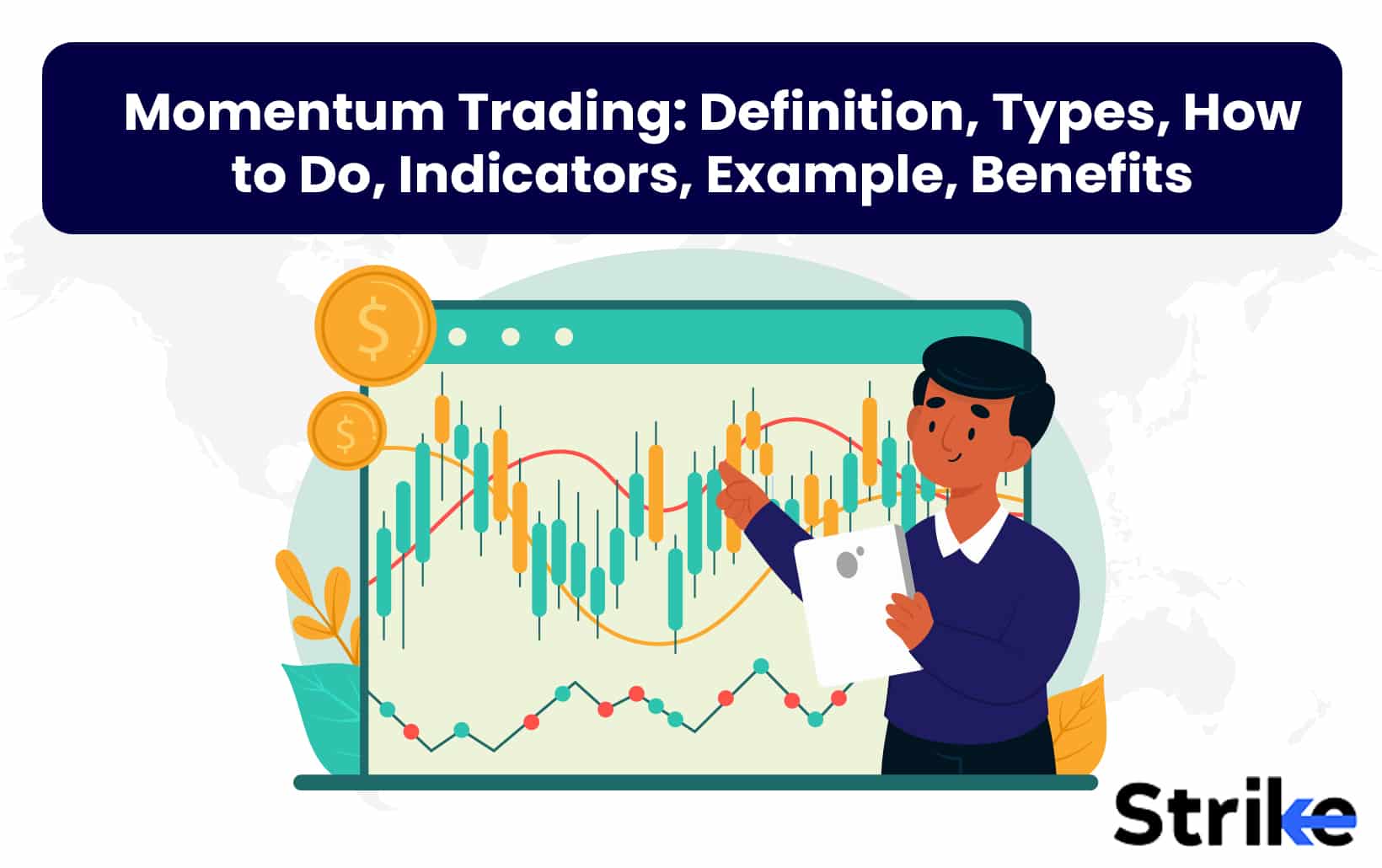
Momentum trading is a strategy that aims to capitalize on the persistence of short-term price trends in the market. Momentum trading is of two main types of momentum – short-term and long-term. Short-term momentum focuses on rapid price changes lasting from days to months. Traders try to ride short bursts of momentum as long as the trend persists. Long-term momentum has a longer investment horizon of quarters to years. It analyses fundamental metrics like revenue and earnings momentum in addition to sustained price trends over longer durations.
Technical indicators play an important role in momentum trading strategies by helping identify when a trend is gathering steam and when it may be weakening. Some of the most popular momentum indicators include the Moving Average Convergence Divergence (MACD), Relative Strength Index (RSI), stochastic oscillator and Average Directional Index (ADI). The MACD signals shift in momentum through moving average crossovers. The RSI and stochastic help determine if a stock is overbought or oversold to find short-term swings. The ADX confirms the presence and strength of a trend.
One key benefit of momentum trading is that it aims to profit from accelerating short-term price trends. By analyzing indicators that identify assets with strong upward or downward momentum, momentum traders can attempt to ride trends from the start and exit as momentum weakens. However, one major limitation is that trends are never guaranteed and are susceptible to unexpected reversals.
What is Momentum Trading?
Momentum trading refers to the strategy of buying securities that are trending up and selling those trending down. There are two main types of momentum – short-term and long-term.
Short-term momentum trading focuses on quick profits from rapid price changes over periods of days, weeks or months. Traders try to identify stocks experiencing strong short bursts of momentum and ride the trend as long as possible. This strategy works best in very liquid markets with lots of movements. The risks include increased volatility and false signals as short-term trends can reverse quickly.
Long-term momentum trading has a longer investment horizon, typically quarters or years. It looks for assets with solid sustained momentum over longer durations. Traders analyze fundamental metrics like revenue and earnings momentum in addition to price trends. The goal is to capture secular bull markets and enduring multi-year price swings. The strategy has lower volatility than short-term trades but identifying early signs of long-term trends can be challenging. The payoff is larger gains from significant price movements over many months or years.
What is the origin of Momentum Trading?
The origin of momentum trading is traced back to the 19th century. In the 1800s, Charles Dow, the founder of the Dow Jones and the Dow Jones Industrial Average, observed that stock prices tended to move in trends. He noticed that stocks rising in price were likely to continue rising, while stocks falling in price would likely continue falling. This observation formed the early basis for what later became known as momentum trading. In the early 1990s, academic researchers like Jagdish Navindra and Sheridan Titman published studies showing that stocks with strong recent performance tended to outperform stocks with weaker recent performance.
Their work brought renewed attention to the idea that momentum, or a stock’s prior price movement, could be used as an indicator for future returns. This helped further establish momentum as a strategy that focused on capitalizing on the persistence of recent price trends. Over subsequent decades, momentum investing gained popularity and many tools were developed to help traders identify and profit from accelerating price trends in the market. This laid the foundational principles and origins of momentum trading as an established strategy used by many investors today. Below is the timeline of events.
| Period | Events |
| 1800s | Charles Dow first observes that stock prices tend to move in trends, with rising prices likely to continue rising and falling prices likely to continue falling. This lays the early foundations of the momentum concept. |
| Early 1900s | While the strategy is not formally defined yet, researchers find evidence of persistent momentum effects in stock markets dating back to the Victorian Era. |
| 1980s/1990s | Academic studies by researchers like Jagadeesh and Titman are published, providing empirical evidence that stocks with strong recent performance tend to continue outperforming for 3-12 months. This brings renewed attention to momentum as a potential factor influencing returns. |
| 1990s | Momentum investing gains wider popularity as a strategy. Tools are developed to help identify accelerating price trends and capitalize on momentum effects in the market. |
| Late 2000s | With advances in computing power, many automated sub-strategies emerge employing high-frequency momentum signals over very short time periods, like hours or days. |
| 2015 | The first ETFs designed specifically for long-term momentum styles are launched, making it easier for investors to gain exposure through passive vehicles. |
| Present | Momentum remains a widely used factor strategy. Continuous research refines an understanding of its risks and behaviors over different market conditions and investment horizons. Momentum effects still persist, though aren’t a guaranteed predictor of future returns. |
How to do Momentum Trading?
Stock selection, risk management, entry, position sizing, and exiting are the important steps to do momentum trading.
1. Stock Selection
Stock selection is the process of identifying and choosing stocks to buy for the purpose of momentum trading. It involves screening for companies that are demonstrating strong price momentum over a period of time, usually the past 1-3 months.
Stock selection is done by analyzing daily price charts that also include common technical indicators like the 50-day and 200-day moving averages to identify assets in a long-term uptrend or downtrend. Below, you see a higher reading in the momentum indicator, reflected by an uptrend. It could mean that this stock is ideal for momentum trading.
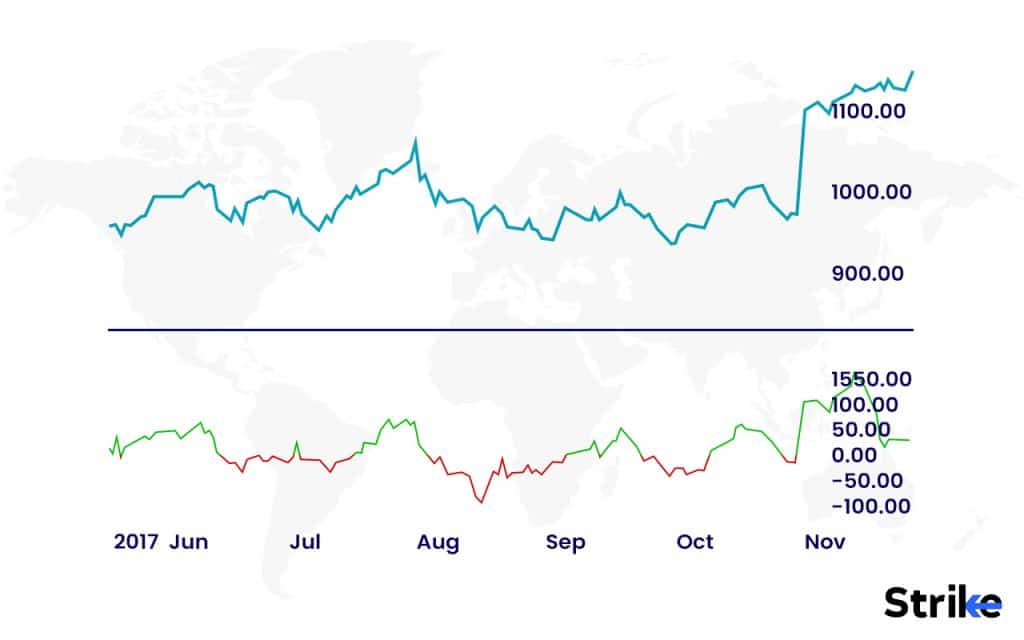
2. Risk Management
Proper risk management is essential when employing a momentum trading strategy. Momentum trades attempt to profit from short-term price trends, but these trends can reverse quickly without warning. To limit their downside, momentum traders use tools like hard stop-losses and profit targets. Hard stops are placed a fixed distance below entry prices on long positions and above on short trades. This automatically exits the trade if the stock moves against the position. Profit targets are also set at a predetermined gain level to lock in profits from successful trades. Together, stops and targets help traders control their risk by ensuring losses are cut at a certain maximum amount and gains are captured before sudden trend reversals.
3. Take an Entry
The third step is to devise an entry strategy using momentum indicators that confirm the strength of the trend. Popular indicators include the Relative Strength Index (RSI), which identifies overbought or oversold levels, and the stochastic oscillator, which signals divergences from trends. Below you will be able to see RSI crossing 70 on multiple occasions, confirming the trend. Hence, this could be considered an ideal entry point.
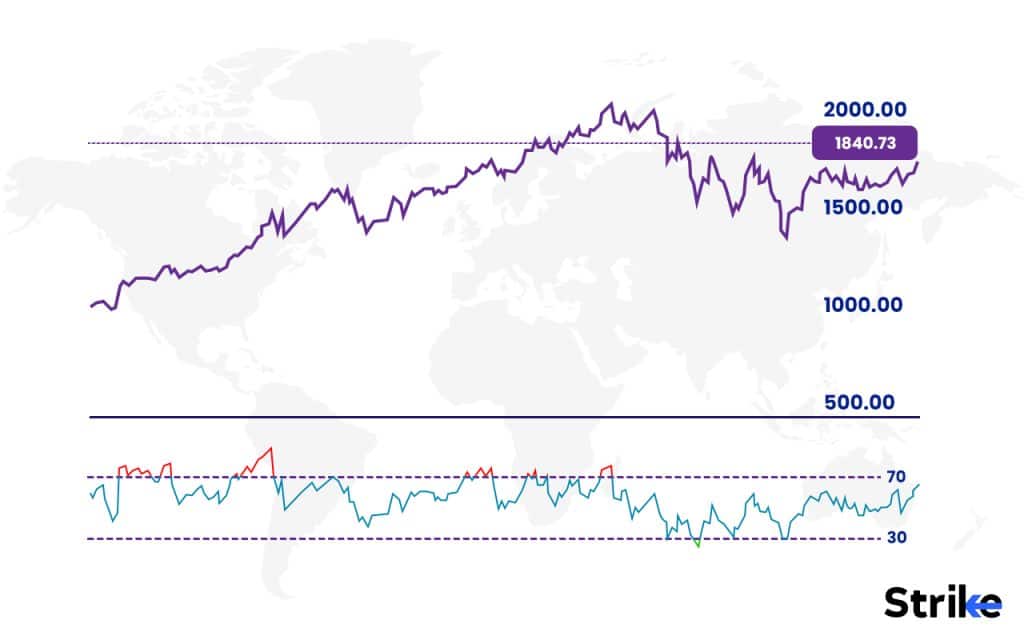
4. Position sizing
Position sizing refers to determining how much of your trading capital to allocate to each momentum trade. A common approach is to risk 1-2% of your account per trade. For example, if you had a Rs. 1 lakh trading account, you would risk Rs. 1,000-2,000 per momentum trade. This allows having 5-10 positions open at a time while limiting drawdown risk on any single trade going against you. You use a percentage of equity to calculate position size. For a long entry on RIL stock trading at Rs. 2,300, risking 1% of Rs. 1 lakh would give a position size of Rs. 1,000/Rs. 2,300 = 0.43 shares. Risking 2% would give a position of 0.86 shares.
5. Exit Timely
The final step is to determine optimal exit prices, usually just above support levels for long positions or just below resistance for shorts. Traders also set stop losses below recent lows or above highs to limit risk. In the below chart, you will be able to see the stochastic oscillator predicting the change in direction. The change in direction is indicated by the signal and indicator line crossing. This helps traders find an exit point.
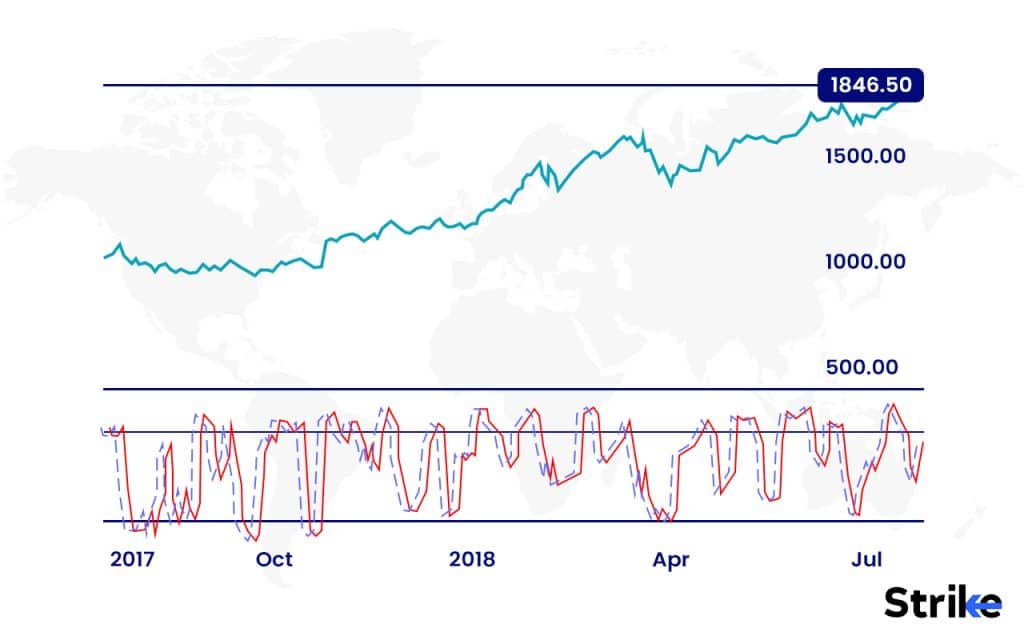
Lastly, executing the trade and closely monitoring the position for changes in momentum signals or price breaks of support/resistance is important. Profits are locked in by selling as the trend confirms on the charts.
Mastering these core concepts allows traders to capitalize on short-term price momentum while controlling downside risk.
What are the best indicators for Momentum Trading?
MACD, RSI, stochastics, ROC and ADX are the best indicators used for momentum trading. Below are more details.
1. MACD
The Moving Average Convergence Divergence (MACD) helps identify both the direction and strength of trends by measuring the difference between two exponential moving averages. The MACD is valuable as a momentum trading tool because it signals when a new trend may be starting or when an existing trend is slowing down and could potentially reverse. Traders watch for crossovers where the MACD line cuts through the signal line, as this indicates changing market momentum. Take a look at the below chart.
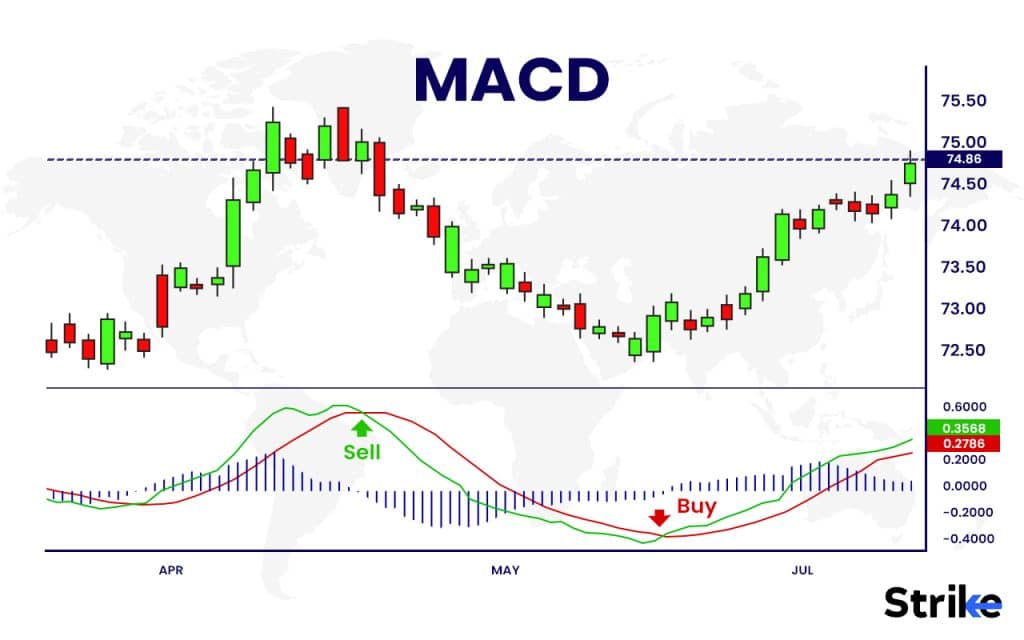
A bullish crossover with the line moving above the signal suggests an uptrend is likely to continue, while a bearish crossover below the signal line hints a downtrend may be strengthening. Divergences between the price chart and MACD can also provide early signals of potential trend changes. By tracking crossovers and divergences on the MACD, momentum traders aim to enter moves near the start of new trends and exit as momentum weakens to maximize profits from accelerating price swings.
2. RSI
The relative strength index (RSI) is used to identify overbought and oversold levels in the market. The RSI evaluates recent gains and losses over a specific period of time, typically 14 periods, and produces values between 0-100. Levels above 70 are considered overbought, while levels below 30 are seen as oversold.
In momentum trading, traders watch for divergences between the RSI and price action. For example, if the price makes a new high but the RSI fails to exceed its previous high, it signals negative divergence and a potential trend reversal. Look at the below chart.
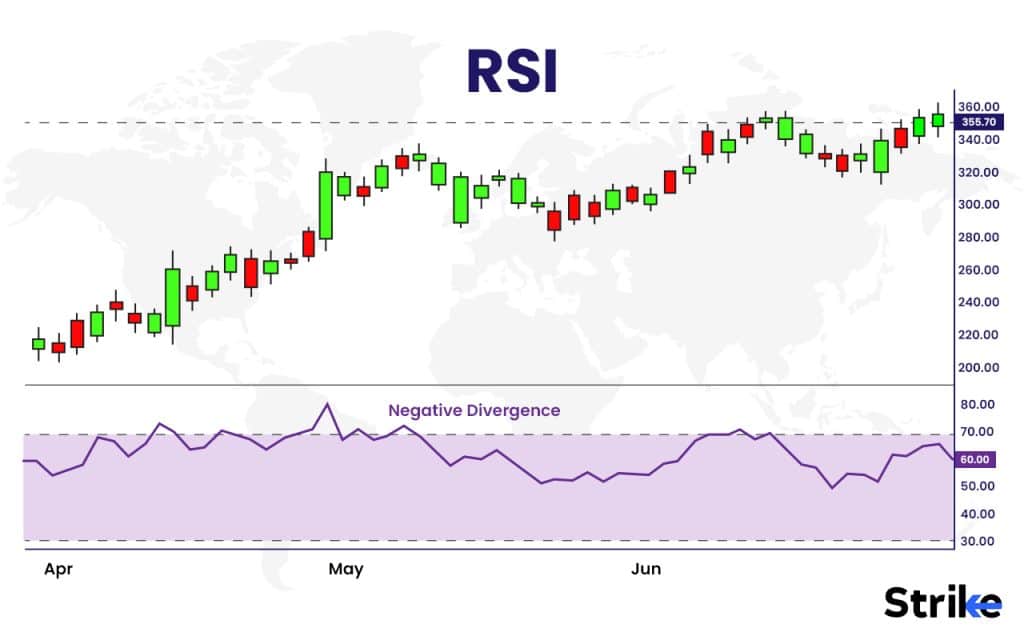
On the chart, traders draw buy entries when the RSI moves up from below 30 (oversold area) and sell signals when it falls from above 70 (overbought). Proper risk management using stops and targets is also critical.
Momentum traders using RSI aim to catch short-term swings riding trends. The sample chart shows RSI moving from 30 to 70, triggering buy and sell signals that captured an upward price move. RSI helps identify high-probability setups for momentum traders
3. Stochastics
The stochastic oscillator compares recent closing prices to a specified period to gauge market momentum. It produces a value that oscillates between 0-100, with readings above 80 considered overbought and below 20 as oversold. Look at the below chart.
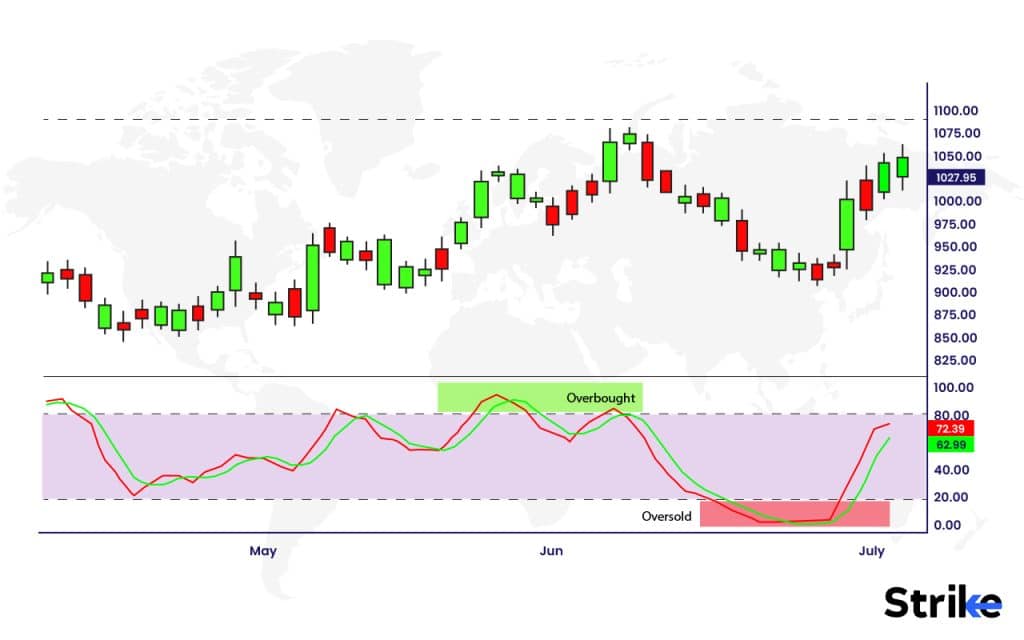
On a chart, momentum traders watch for the fast stochastic line (blue) to cross above the slow line (orange) as it rises from the oversold zone below 20. This signals that short-term momentum has shifted to the upside and a trading opportunity exists. As seen in the sample chart, a buy was triggered when the lines crossed after the fast line moved up from the oversold level. The trade was then closed out as the lines approached the overbought zone above 80.
Divergences between the price action and stochastic can also provide signals. A new high in price with the stochastic failing to make a new high suggests weakening momentum. By tracking crossovers and divergences of the stochastic lines on various timeframes, momentum traders aim to ride trends from start to finish. This strategy attempts to profit from persisting short-term price momentum using the stochastic oscillator.
4. ROC
The Rate of Change (ROC) indicator is a momentum oscillator that measures the per cent rate of change between the current price and the price a certain number of periods ago. It helps identify whether a stock’s price is rising or falling over the selected time period.
Momentum traders watch for divergences between the ROC line and price, such as making a new high when the ROC fails to exceed its previous high. This signals weakening momentum. See the chart.
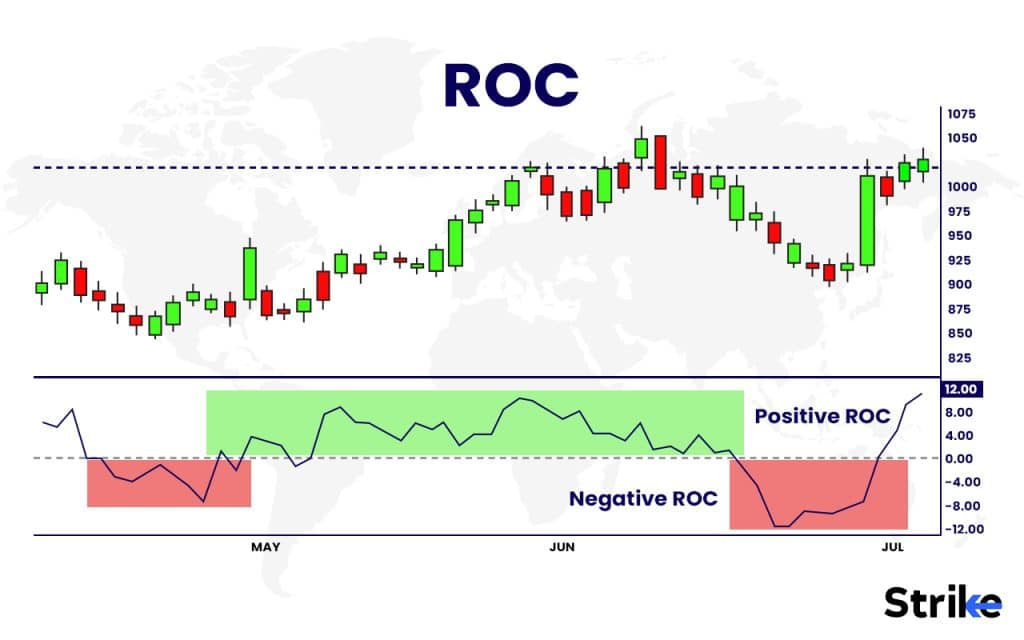
In the chart, the ROC was rising from below zero (oversold territory) forming higher highs and lows along with price action. A buy signal would have been generated on the crossover above zero. The position was then exited as ROC turned down from an overbought level above +20%, confirming the upward trend had halted.
5. ADX
The ADX indicator is used to measure the strength of a trend. It is comprised of three lines – the ADX itself along with the +DI and -DI lines. The ADX line specifically ranges from 0-100, with readings of 20 and above generally indicating a strong trend. In momentum trading using the ADX, traders look for the ADX line to rise above 20 as prices move in one direction. This confirms the trend is strengthening. See the chart below.
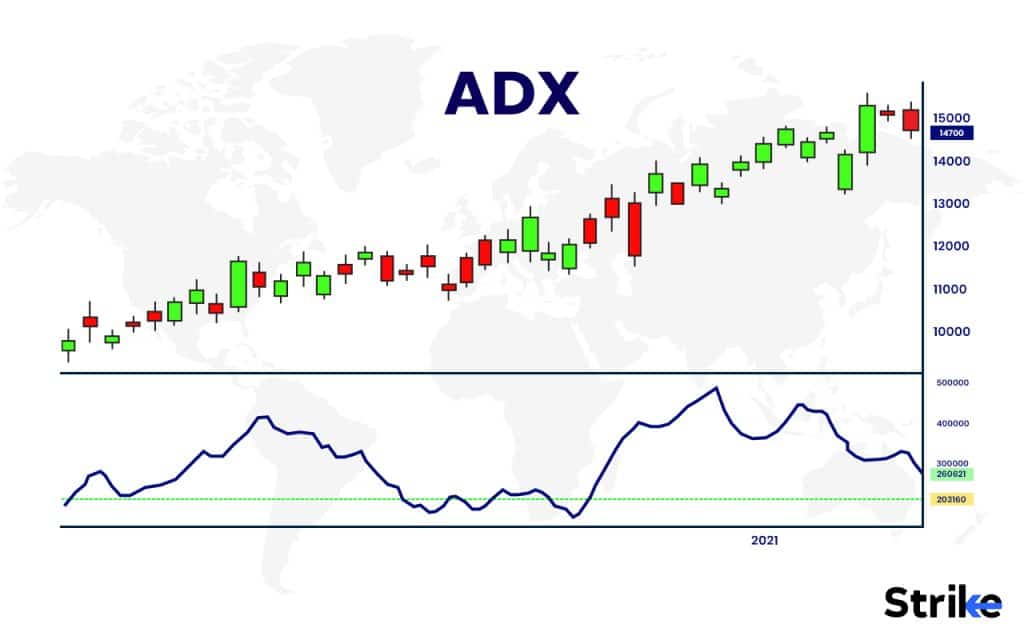
In the chart above, the ADX rose above 20 as prices trended upwards, signalling a buy opportunity. A trader would enter long and place a protective stop below the recent lows. As the ADX started to slope downwards from peaks above 30, it provided an early warning that the upward trend was weakening, cueing traders to take profits.
Each indicator provides a distinct way to identify changes in the strength and direction of trends. The key is understanding price action and trends and then letting the indicators validate events as they unfold on charts.
What is an example of Momentum Trading?
Let us look at a real life example of momentum trading. Here, we look at the chart of RIL.
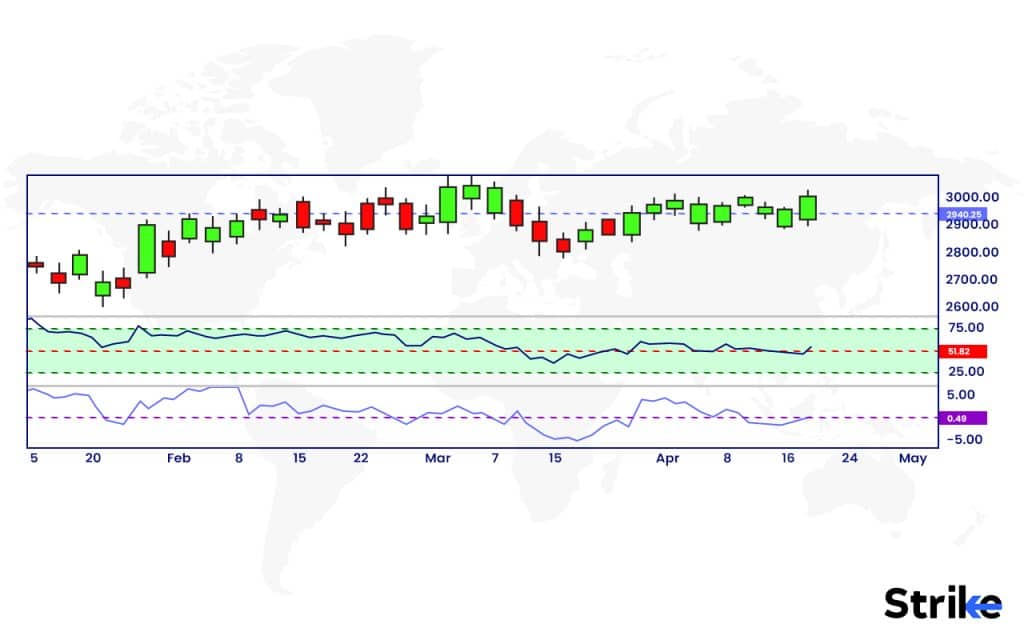
Look at the arrows in the chart below. Here, RSI is showing signs of an uptrend and it is confirmed by ROC. The confluence of the RSI and ROC pointing higher suggests this uptrend has strong legs. The series of higher highs and higher lows on the price chart also confirms the bulls are in control. As the arrows indicate, this stock looks poised to continue marching higher. The next resistance level appears around 75 based on the prior highs. Given the strong technicals, a break above 75 could lead to an extended move towards 85 or even higher.
What are the tools required for Momentum Trading?
Screener Plus is one of the technical analysis tools available on Charles Schwab’s trading platform, while Thinkorswim allows for custom indicators and screeners to be built using its built-in thinkscript language. But for Indian investors, Strike provides one of the best options. Strike is a user-friendly Indian stock market analytical tool that offers several advantages over these platforms.
It provides customized dashboards for traders to display key market data and tailor their experience based on strategy. Strike’s comprehensive set of indicators and scanners helps identify profitable trading opportunities. Its mentorship program and extensive tutorials are useful for learning technical analysis. Strike covers market news and insights, sentiment analysis, and futures and options trading.
What are the benefits of Momentum Trading?
Momentum trading’s main benefit is that it helps you take advantage of market trends. Below are the advantages outlined.
Profit from trends
Momentum trading aims to profit from accelerating short-term price trends by identifying assets with strong upward or downward momentum. This allows riding trends from start to finish.
Technical approach
Momentum strategies are purely technical, relying on indicators and patterns without considering fundamentals. This makes the approach simpler for traders focused only on price action.
Short time horizon
Most momentum strategies have a short time horizon, suitable for day traders. This allows taking quick profits from intraday or short-term swings without needing to hold positions for long.
Objective signals
Technical indicators like MACD, RSI and ADX are triggered by hard criteria and provide objective entry and exit signals. This removes emotions from the trading process.
Simple to understand
The concept of riding the persistence of trends is easy to grasp. Traders can learn momentum strategies quickly without advanced theoretical knowledge.
Leverage volatility
Since momentum trading capitalizes on accelerating trends, it aims to benefit from periods of high volatility in the market when large short-term moves occur.
Understanding the key principles of momentum, from identifying trends and timing trades to managing risks, is integral for traders looking to successfully implement this strategy.
What are the limitations of Momentum Trading?
Momentum trading relies on the continuation of short-term price trends. However, trends are never guaranteed and are susceptible to unexpected reversals. As momentum traders follow the herd, any shifts in overall market sentiment can quickly turn a profitable trend against their position. This highlights the risk of trading on the backs of other investors in the market.
Another limitation is that momentum strategies tend to have very high turnover as positions are opened and closed rapidly based on technical indicators. The frequent trading required to stay with trends as they develop and decay leads to increased trading costs over time from commissions, fees and bid-ask spreads.
Momentum strategies are known to experience large drawdowns during major market crashes and corrections. Since trends in such volatile periods are shorter-lived, momentum signals may not have enough time to predict reversals. This exposes traders to elevated downside risk during periods of heightened fear in the markets. Some research has found “residual” momentum approaches that remove general market influences can help reduce the severity of drawdowns.
Is Momentum Trading profitable?
Yes, momentum trading will be profitable when trends, driven by supply & demand, persist long enough and trades are timed accurately with the help of technical indicators. However, trends, influenced by shifts in supply & demand, are unpredictable and make the strategy very risky.
What is the difference between Momentum vs Swing Trading?
Momentum trading focuses on very short term trends lasting from a few hours to a few days, while swing trading targets mid-term trends lasting several days to weeks by identifying momentum shifts and breaks in trends. The difference between the two lies primarily in the duration of trends traded – momentum targets micro-trends while swing trading analyzes slightly longer trends within an uptrend or downtrend.







![85 Common Stock Market Terminologies for Dummies [Updated List for 2026] 112 85 Common Stock Market Terminologies for Dummies [Updated List for 2025]](https://www.strike.money/wp-content/uploads/2025/04/Popular-Stock-Market-Terms-for-Beginners-Banner.png)










No Comments Yet.